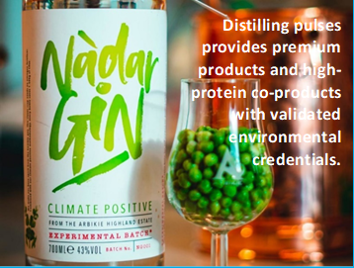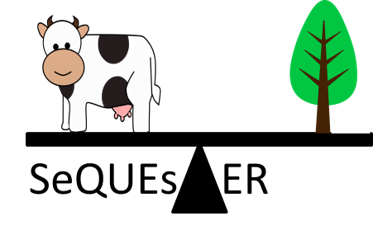What can Ireland learn from other countries as it transitions agriculture towards carbon neutrality?

Ireland is already a major player in a globalised food system. Its mainly family owned farms allow the country to be a major exporter of meat and dairy products. The future vision for sustainable economic development of this market sees the premiumisation of the goods as key to increasing their export value. This expectation is reasonable, as global demand for meat and dairy products is set to increase significantly, even if consumption in Europe plateaus or declines. However, like many parts of Europe, Irish supplementary animal-protein-feed requirements are satisfied via high import dependency (up to 70%), with the pig, poultry and dairy sectors consuming 50% of these imports as GM (genetically modified) soybean sourced mainly from ex-biodiverse areas of the Amazon and cerrado regions of the Central Americas’. Therein lies a conflict, since increasing awareness among consumers of such issues means that premiumisation will demand satisfying increasing demand for food stuffs which are: non-GM; organic; offer improved organoleptic and nutritional qualities; are provenanced (i.e. local, craft and/or artisanal); and with validated environmental and biodiversity (protection) credentials for both products, and the farms which generate the crops

This is likely to demand a move towards increasing national capacities for greater feed protein self-sufficiency. In this context, it seems that Ireland is setting the examples for other countries to follow, than vice versa, since there are major Irish led projects (such as Smart Protein), testing alternative protein sources, including feed protein isolation from: clover-grass biorefining, algae, fungi, insects, more -efficient use of ‘waste materials’, or as they are more correctly termed these days ‘co-products’. Market adaptation will extend to the development of plant-based meat and dairy products too.

Many of the new plant-based products utilise the high protein grains of legumes, which belong to the same plant family (Fabaceae) as forage legumes such as clover that is prevalent in pasture systems in Ireland. Leguminous crops do not normally require application of synthetic nitrogen fertiliser, and their nitrogen needs are met by a natural process termed ‘biological nitrogen fixation’ – whereby largely inert atmospheric di-nitrogen gas is converted into biologically useful nitrogen. This nitrogen fixation process occurs in legume root-nodules and is mediated by a symbiotic relationship between naturally occurring soil microbes, collectively termed rhizobia. Grain legume crops which can be grown in Ireland include species such as peas (Pisum sativum L.) and faba beans (Vicia faba L.). Though cultivation of the former present less agronomic challenges than the latter since peas tend to ripen much earlier. However, faba beans offer grain with high protein levels, and return greater quantities of nitrogen in crop-residues left in-field that act as a natural ‘green manure’, and further offset synthetic nitrogenous fertiliser requirements for crops which follow in the rotation. Yellow- (also known as white-) pea has emerged as the crop of choice for large scale processors targeting high-value human food markets. Faba bean is also following close behind in this market, and novel species such a lentils (Lens culinaris Medik.), common bean (Phaseolus vulgaris L.), and even soybean (Glycine max Merr.) varieties are being screened to identified types that perform well in Atlantic and boreal biogeographical regions:
But are there any strategic national breeding, or even screening, programs?

Crucial to the market success of such crops are several foundation elements including the availability of varieties best suited to Irish pedoclimates. It is also important that producers have easy access to independent specialist agronomy advice on legumes, from agencies equivalent to: the UKs Processors and Growers Research Organisation (PGRO, www.pgro.org); farmer discussion forums; and, specialist crop-species networks, as exemplified in Germany for lupins. In the UK, ADAS has recently established the Pea and Bean Yield Enhancement Networks. Such partnerships demonstrate that strategic collaboration across the value-chain is crucial too. Grain legume market leaders, such as Canada, have national associations of growers, traders and processors in the form of Pulse Canada. Improved profitability at the farm level is not usually simply a function of yield but of optimising the production environment, and especially soil attributes, to ensure crops of consistent high-quality, and to minimise reliance upon costly external inputs. National capacities for post-farmgate processing are essential requirements too, such as for legume grain dehulling, milling and protein-/starch-fractionation, and associated food technology expertise. The latter is especially important, as the various processing approaches offer different functionalities:
Do these capacities exist, and at significant commercial scales, within Ireland?
The transformation towards carbon neutrality, and natural nitrogen cycling, will demand an improved balance of ‘pull’ and ‘push’ factors among value-chain stakeholders. Consumer ‘pull’ is already being generated:
But is the producer and processor ‘push’ in place?
With the right support, arable systems can become more sustainable by increasing grain legume inclusion in crop rotations from current levels of ca. 1% (or less), to the required 15 % (or more), and this level of inclusion can be achieved without loss of total productivity.
About the author

Pietro (Pete) Iannetta, is a Head of Ecological Food Systems, a sub-group of the James Hutton Institute’s Agroecology Group. The Institute is a Main Research Provider to the Scottish Government, and he serves the Governments Strategic Research Programme as Principal Investigator leading research on: Novel crops and cropping systems’; ‘Biodiversity and ecosystem functions’; ‘Integrated Pest Management’; ‘Alternative approaches to sustainable land management’; and, ‘Integrated Management Systems’. Currently, Pete is also Coordinator of the www.TRUE-Project.eu, a Coordination team member of www.plant-teams.eu, and a work package leader to www.tomres.eu. He also serves as expert external advisor to the DiverBeans project funded by the COOP via the World Food System Centre (ETH Zürich).
Acknowledgements
‘TRansition paths to sUstainable legume-based systems in Europe’ (TRUE), is a Research & Innovation EU-H2020 project funded by the European Commission project funded under Grant Agreement Number 727973. The TRUE-Project is Coordinated by the James Hutton Institute (HUTT) (Scotland UK), and the Institute is supported by the Rural and Environmental Science and Analytical Services (RESAS), a Division of the Scottish Government.
